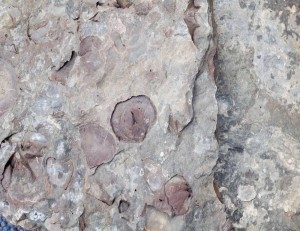Geologic History
Greenwoods rests on the northern edge of the Appalachian plateau in central New York. The plateau is gently etched with rivers which drain south to the Susquehanna River, and ultimately to Chesapeake Bay. Devonian age sedimentary rocks, (407 to 385 million years old) underlie the area around Greenwoods Conservancy. These sediments were deposited into a marine setting, which started off as a shallow warm sea (Onondaga limestone was deposited), then experienced a large influx of terrestrial muds from erosion of mountains that lay to the east (Marcellus, Panther Mountain, and Moscow formations), and sediments from this event are known as the Catskill delta. The seas gradually waned, and retreated. A long period of time elapsed, when these sediments were buried and lithified into sandstone and shale, then uplifted and eroded by streams. During this time period, a series of mountain building events occurred farther east, but those events are not recorded in the sediments under Greenwoods, except, perhaps, by the presence of regionally extensive fractures, which likely formed as a consequence of compressive stresses from continental collisions south of the region.
In Pennsylvania, younger sedimentary rocks than those underlying Greenwoods are strongly folded and overthrust, documenting the continental collision. Some modern stream locations follow those fractures. The linear ridge and trough which holds Cranberry Bog follows one of these fractures. 180 million years ago, North America began to separate from Africa, and the Atlantic Ocean formed. About 2 million years ago, glaciers advanced repeatedly over the area from Canada, and further sculpted the valleys, and buried much of the lower valley floors during the last glacial retreat, about 13-14,000 years ago. The glaciers scoured depressions into some of the uplands, and these basins were later filled with lakes and bogs.
Click here to view the full report.
Click here to view 20th Century History.

